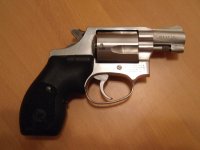The one issue that has me on the fence regarding the 37 is "frame cracks" that have been well noted here and elsewhere. .... Just not sure how much of a real problem this cracking issue is for the older guns ?
I had the same concerns when I bought my M37.
I'm an engineer, although electrical and computers are my focus and I'm not a mechanical or materials engineer.
But, in general, most systems fail as follows:
1. They fail when the product is fairly new, usually due to a design or manufacturing problem. In the case of a m37, this might be because the barrel was over-tightened by the factory creating stress or even the beginnings of a crack.
2. If you get past the infancy failure problem above, then systems usually fail because they are abused in some way. In this case, one form of abuse would be using +P ammo in a gun not intended for it. In the case of an M37, I realize many people get away with using +P, but I think you still are subjecting the gun to stresses it wasn't designed for and risking cracks or other problems.
3. Systems fail because they wear out. Nothing lasts forever. If you buy an aluminum gun which has already fired 20,000 rounds you can expect it to just plain wear out at some point. Metal fatigue cracks are one example of how mechanical systems wear out.
So I'd say if you want an M37 just buy it. If the frame cracks, you may be able to get S&W to make it right -- even though you aren't the original owner.
If not, then you are out some money, and need to buy another gun. Remember nothing lasts for ever, anyway.
Finally, there is no guarantee an M60 won't also suffer some problem or a frame crack.
Or course, don't buy a gun that is already cracked.
There is no certainty in life -- so I won't let worrying about low probability events that might happen keep me from doing what I want to do.
FWIW
Dave


